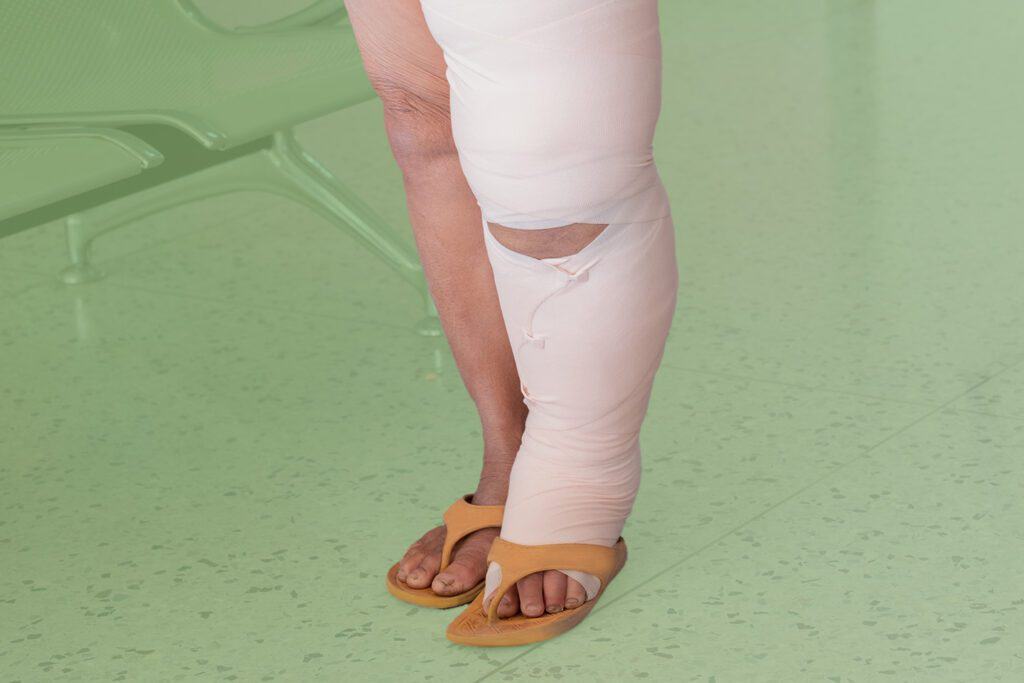Also known as combined venous and lymphatic insufficiency, venolymphatic insufficiency, mixed edema, venolymphedema, venous-lymphatic disease, dual insufficiency of the venous and lymphatic systems.
Phlebolymphedema is a chronic condition characterized by a combination of venous insufficiency and lymphatic dysfunction. It involves impaired circulation in the veins, leading to fluid buildup (edema) in the affected limb, along with lymphatic dysfunction, which further contributes to swelling and tissue damage.
Phlebolymphedema is a progressive condition that can worsen if left untreated. Without proper management, it can lead to complications such as skin changes, recurrent infections, and ulcerations. However, with appropriate treatment, including compression therapy and lifestyle modifications, symptoms can often be managed effectively, and progression can be slowed or halted.

Lifestyle changes such as maintaining a healthy weight & diet, exercising regularly, avoiding prolonged sitting or standing, and elevating your legs can play a significant role in managing lipodermatosclerosis and reducing its symptoms.
Radiofrequency Ablation (RFA), the most common method for vein therapy, uses heat energy in a minimally invasive fashion to close an offending vein. During the treatment, a thin, flexible catheter is inserted into the body to send out radiofrequency waves which heat the tissue. This cauterizes and closes the offending vein, thus shifting blood flow to a healthier system.
Varithena is a type of foam sclerotherapy used to treat varicose veins. It’s a minimally invasive procedure that involves injecting a foam solution directly into the affected veins. The foam displaces the blood within the vein, allowing the sclerosant (a medication that causes the vein to collapse) to come into direct contact with the vein wall.
Phlebolymphedema stages typically begin with mild swelling and discomfort in the affected limbs. As the condition progresses, the swelling becomes more pronounced, and the skin may thicken, leading to fibrosis (scarring) and reduced mobility. In the most advanced stages, the swelling can be permanent, and the skin may become harder and more resistant to treatment.
Phlebolymphedema symptoms include swelling in the legs or arms, which may worsen over time, especially after standing for long periods. Patients may also experience a feeling of heaviness, aching, or tightness in the affected limb. In more severe cases, fibrosis, or thickening of the skin and tissues, can develop, making the limb feel hard to the touch.
Phlebolymphedema causes are typically linked to a combination of chronic venous insufficiency and lymphedema. The condition occurs when problems with the veins, such as varicose veins or blood pooling, lead to impaired lymphatic drainage, resulting in swelling and fibrosis in the affected limb. Other factors like obesity, genetic predisposition, or injury can contribute to the development of phlebolymphedema.
Phlebolymphedema fibrosis refers to the thickening and hardening of the skin and tissues in the affected limb due to chronic swelling. This fibrosis can limit the range of motion and make the condition more difficult to treat. Early intervention to manage swelling can help prevent or slow the progression of fibrosis.
Chattanooga | Cleveland | North Georgia | Jasper | Dayton | Hixson

Monday: 8 AM – 5 PM • Tuesday: 8 AM – 5 PM • Wednesday: 8 AM – 5 PM • Thursday: 8 AM – 5 PM • Friday: 8 AM – 5 PM • Saturday: Closed • Sunday: Closed
Monday: 8 AM – 5 PM
Tuesday: 8 AM – 5 PM
Wednesday: 8 AM – 5 PM
Thursday: 8 AM – 5 PM
Friday: 8 AM – 5 PM
Saturday: Closed
Sunday: Closed
Call now to book an appointment.
Conveniently located near Northgate Mall.